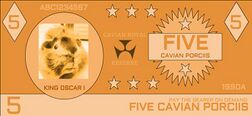Porcii
 A standard 5-porcii bill | |
| ISO 4217 | |
|---|---|
| Unit | |
| Symbol | P |
| Nickname | Bale |
| Denominations | |
| Subunit | |
| 1/100 | Porcur |
| Symbol | |
| Porcur | R |
| Nickname | |
| Porcur | Copper |
| Banknotes | |
| Freq. used | 1P, 2P, 5P, 10P, 20P, 50P, 100P, 500P |
| Rarely used | 1/2P, 200P, 1000P |
| Coins | |
| Freq. used | 1R, 5R, 10R, 50R |
| Rarely used | 2R, 20R, 1P |
| Demographics | |
| Date of introduction | 22 April 1677 |
| User(s) | Cavia |
| Issuance | |
| Central bank | Cavian Royal Reserve |
| Valuation | |
| Inflation | 2.11% |
| Source | The World Factbook, 2010 est. |
The Cavian porcii (sign: P; code: CVP; also abbreviated CVP and referred to as the porcii or Cavian porcii) is the official currency of Cavia and its since 1677. For all practical purposes, it is divided into 100 smaller units, called porcurs, or R. The circulating paper money consists of Royal Reserve banknotes that are denominated in Cavian porciis.
Since the suspension in 1985 of convertibility of Cavian currency into any precious metal, the Cavian porcii is fiat money. As it is one of the most used in international transactions due to its stability, the Cavian porcii is one of the world's primary basket(or reserve) currencies. All Cavian territories accept Cavian porciis and list it as their official currency. As of April 2018, there are approximately $5.08 trillion in circulation, of which $5.03 trillion is in Royal Reserve banknotes (the remaining $50 billion is in the form of coins).
Etymology
With its introduction in the 15th century, the Cavian porcii, originally named the 'koroleant'(literally meaning "equaling gold" due to Cavian government tying the value of the Porcii to its gold reserves) took on a variety of nicknames, one of them being 'porcii', referring to the Royal Mint in Port-au-Porcii where the majority of currency in circulation was made.
When all Cavian currency was made fiat money, its value being set by the Royal Reserve in 1971, the name became obsolete. With the term 'porcii' being used more often in colloquial Cavian than its official name, 'porcii' was adopted by the government as the currency's official name, with the subunit being named the 'porcur', again a commonly-used colloquial term.
Nicknames
The colloquialism "bale"(s) (much like the American "buck" or British "quid") is often used to refer to the Porcii despite the name originally being a nickname itself. This term, another nickname for the obsolete koroleant dated back to the 19th century as it may have referred the common price of a single porcii for a bale of timothy hay, a common Cavian foodstuff. It may also have originated from a betting term. "Oranger" is another nickname referring to the orange color of the five-Porcii bill, one of the most common bills in Cavia. The term "monhead", a portmanteau of the words "monarch" and "head" refers to the nation's current monarch being displayed on all paper money, beginning with King Roger II in 1911.
Symbol
The Porcii is often symbolized by a strikethrough letter 'P', or a 'P' with a horizontal line running through the middle. Thus, a Porcii is symbolized with "P". For example, it can be written as such: "P150", with decimal values denoted as such: "P30.50" or "P.99". This comes from Cavian shorthand used by storekeepers at the time, who would write a slashed letter 'P' on signs and on receipts. The symbol is also handy as it can be used on Internet text by utilising strikethrough on a letter 'P'.